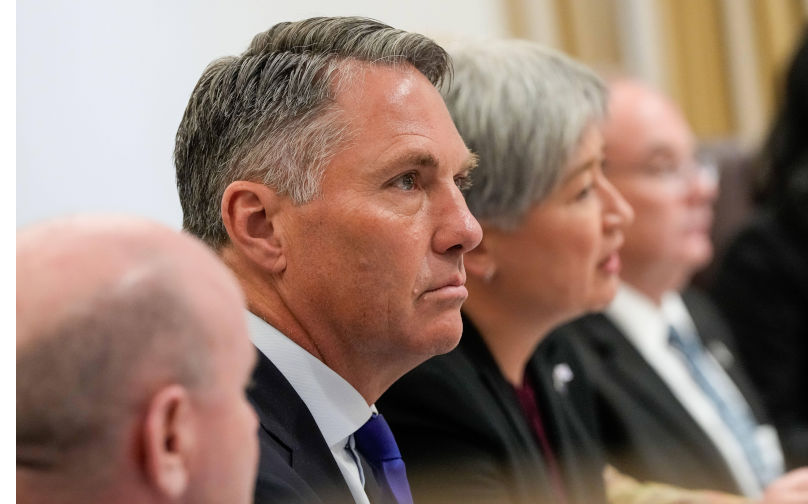Perhaps Marles should ask the US why it is building up forces around China
June 15, 2025
It now seems taken for granted that Australia needs to spend a lot more on its military.
Fortunately, if needed, Australia could increase its military capability without spending any more. The lesson from Ukraine and elsewhere is that Australia should put a much bigger focus on drones than on getting more conventional warships and fighter planes.
At the last election, the Coalition promised to buy an additional 25 F-35 fighter planes. These planes are basically useless for the defence of Australia. Those that took off from their base outside Newcastle would have to turn around before they reached the Queensland border unless they were aerial refuelled. The same applies to F-35s taking off from their base at Tindal in the Northern Territory. They would have to be refuelled not long after flying beyond the Australian border. The difficulty is the large refuelling planes would be easy to detect by radar and shot down.
There have also been strong calls for Australia to increase its surface fleet. It has already doing so by building British-designed frigates in Australia. These big ships and similar ones will be sitting ducks in a war where they can be sunk by hypersonic missiles and torpedoes.
However, Australian Defence Minister Richard Marles has called on China to explain why it needs to have “such an extraordinary military build-up”. Although he doesn’t appear to have noticed, China’s build-up is lower as a share of GDP terms than Australia’s 2%. He said Beijing needs to provide greater transparency and reassurance as it is the “fundamental issue” for the region. The much more important question is why is the US building up its forces around China, so far away from its home continent? It is not clear whether Marles sought cabinet endorsement for this aggressive, and inaccurate, statement.
There is nothing extraordinary about China‘s military build-up. According to the Stockholm International Peace Research Institute, China has been spending a relatively modest US$314 billion on defence (or 1.72% of GDP) compared to US$997 billion for the US (or 3.4 % of GDP). The well regarded Peterson Institute says US spending is higher than the total for the next nine countries.
The growth of Chinese defence spending has been steady in percentage terms over several years. The World Bank says since China opened up and reformed the economy in 1978, GDP growth has averaged more than 9% a year. More than 800 million people have been lifted out of poverty. There have also been significant improvements in access to health education and other services. As expected, GDP growth has been more modest in recent years.
There is nothing surprising about China improving its defence forces. It is confronted by a large military build-up close to its borders by the US and its allies. China has not built up its forces around mainland US or anywhere close to them. China is adopting the same policy that Australia used to have, of defending the approach to its borders.
More recently, Australia has announced that it will buy eight submarines with nuclear reactors. The prime minister at the time, Scott Morrison, explained these submarines were to provide Australia with a “forward defence” posture against China which entails firing cruise missiles into the Chinese mainland. The official cost of these, about $400 billion, will probably be much higher. Yet technological developments are making it easier for them to be detected. The extremely hot water used by the nuclear reactor to heat the submarines’ steam engines have to be expelled from the hull. This leaves an infrared signature that can be detected from space. The steam engines propel the submarine. The nuclear reactor is simply part of a glorified hot water system.
Marles has repeatedly said that he wants to give the Australian Defence Force increased “lethality”.
In another aggressive move, he has approved Australian Long Range Maritime aircraft dropping sonar buoys into the South China Sea to record the sounds of Chinese submarines and other ships to help detect them in a future war. He has also supported using Australian anti-submarine helicopters to dunk sonar buoys in the vicinity of Chinese military exercises in the Yellow Sea.
More recently, many Australian commentators have reacted strongly to a Chinese cruiser, frigate and supply vessel conducting live firing exercises in international waters well clear of Australia. Retired senior Australian naval officers pointed out they often conducted live firing exercise exercises and China was fully entitled to do the same.
Australian journalists often falsely report that Taiwan is an independent country that China now wants to take over. Taiwan is not independent. Most countries accept it is effectively part of China. The US and Australia did so in the 70s. However, China, and other countries in the vicinity, need to reduce the temperature in talking about the offshore aspects of claims to sovereignty that were originally made by the Nationalist Party of China and later adopted by the Communist Party.
Australia is a remarkably safe country. Unlike China, it doesn’t share land orders with any other country. China has no motive to attempt the extremely difficult task of occupying Australia, although Marles seems determined to give it one. He should take more notice of the then foreign minister Julie Bishop’s statement in January 2018: “We do not see Russia or China posing a military threat to Australia."
The views expressed in this article may or may not reflect those of Pearls and Irritations.

